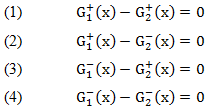![[C# Helper]](../banner260x75.png)
|
|
 |
![[Beginning Database Design Solutions, Second Edition]](db2_79x100.png)

Title: See where two ellipses intersect in C#, Part 2
First recall the quadratic formula. If ax2 + bx + c = 0, then: 



Notice that the equation contains a square root that can be positive or negative. Let Now consider a second conic section defined by: 

 and and  to represent this equation with the positive and negative square roots. to represent this equation with the positive and negative square roots.
The two curves intersect where they have the same x and y values. In other words, those points have x coordinates where G1(x) = G2(x) or G1(x) � G2(x) = 0. Considering all four combinations of positive and negative roots in the equations gives these four equations: 
Note that some of the equations may contain square roots of negative numbers and in those cases they don't have real solutions.
Note also that one or both of the equations might have duplicate roots. In other words, it might use the same value for both of its roots. For example, imagine two ellipses that intersect at four points. Now slowly pull one to the side. Two of the points of intersection grow closer and closer until they coincide. At that point, one of the equations has two roots and the other has a repeated root. Unfortunately the four equations that define the points of intersection are really messy. For example, equation (1) is: 
To use Newton's method to find the roots (zeros) of an equation, you need to find the derivative of that equation. The derivative of G1(x) is given by: 

Simple isn't it? Well... not really. See the post Use Newton's method to find the roots of equations in C# for information about Newton's method. In the next post, I'll summarize this method for finding intersections between conic sections and explain what the program shown in the picture at the top of this post actually does. Download the example to experiment with it and to see additional details. |
![[Beginning Software Engineering, Second Edition]](book_sw_eng2_79x100.png)
![[Essential Algorithms, Second Edition]](book_algs2e_79x100.png)
![[The Modern C# Challenge]](book_csharp_challenge_80x100.jpg)
![[WPF 3d, Three-Dimensional Graphics with WPF and C#]](book_wpf3d_80x100.png)
![[The C# Helper Top 100]](book_top100_80x100.png)
![[Interview Puzzles Dissected]](book_interview_puzzles_80x100.png)
![[C# 24-Hour Trainer]](book_csharp24hr_2e_79x100.jpg)
![[C# 5.0 Programmer's Reference]](book_csharp_prog_ref_80x100.png)
![[MCSD Certification Toolkit (Exam 70-483): Programming in C#]](book_c_cert_80x100.jpg)
 This post shows The Ugly Math that you can use to see where two ellipses intersect. Brace yourself! Here it comes!
This post shows The Ugly Math that you can use to see where two ellipses intersect. Brace yourself! Here it comes!
 be the equation with the positive root and let
be the equation with the positive root and let  be the equation with the negative root.
be the equation with the negative root.
 Note also that one of the equations might have more than one root. For example, in the picture on the right, the bottom of the red ellipse overlaps the top of the blue ellipse. If the red ellipse is ellipse number 1, then the bottom of the red ellipse is generated by equation
Note also that one of the equations might have more than one root. For example, in the picture on the right, the bottom of the red ellipse overlaps the top of the blue ellipse. If the red ellipse is ellipse number 1, then the bottom of the red ellipse is generated by equation
 .
.